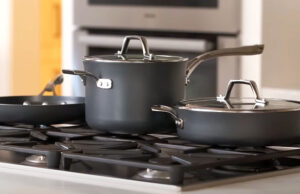As an Amazon Associate, I earn from qualifying purchases at no extra cost to you.
How to Reset a KitchenAid Dishwasher: Expert Guide
You know that feeling when your KitchenAid dishwasher stops working just when you need it most? Don’t worry! Sometimes, all it needs is a simple reset. If you’re struggling to figure out what to do when your dishwasher isn’t cleaning as expected or is stuck in a cycle, resetting it can often solve the problem. In this article, I’ll walk you through the steps to reset your dishwasher and get it back to work.
Understanding Why You Might Need to Reset Your KitchenAid Dishwasher
Before jumping into the reset process, it’s important to understand why your dishwasher might need a reset. There could be several reasons, ranging from technical issues to minor glitches that disrupt its performance. A reset can clear most of these issues by rebooting the appliance and restoring it to its original settings.
Common Issues That Can Be Solved by a Reset
A reset is a quick and easy solution to several common problems that may arise with your KitchenAid dishwasher. These issues can include:
- The dishwasher stops mid-cycle.
- The lights on the control panel are flashing or not responding.
- The dishwasher refuses to start.
- The cycle doesn’t finish properly.
- The dishwasher is making unusual noises or not draining.
In many cases, these problems are due to software glitches or minor electrical hiccups. A reset clears the dishwasher’s memory, allowing it to restart and possibly fix the issue.
When Should You Reset Your Dishwasher?
If you notice any of the issues mentioned above, it’s a good idea to try resetting your dishwasher first. However, if the problem persists after a reset, you might be dealing with a more serious issue, such as a malfunctioning part. In this case, it would be best to contact a professional technician for further assistance.
How to Reset a KitchenAid Dishwasher: Step-by-Step Guide
Now, let’s dive into the process of resetting your KitchenAid dishwasher. It’s not as complicated as it might sound! Follow these simple steps, and you’ll have your dishwasher running smoothly in no time.
Step 1: Unplug the Dishwasher
The first thing you want to do is unplug your dishwasher. This is one of the easiest ways to reset the machine. By cutting off the power, you give the appliance a chance to reset and clear any electrical issues that might have occurred.
- Locate the power cord of the dishwasher.
- Unplug it from the power outlet.
- Wait for at least 1 to 2 minutes to ensure that the dishwasher has completely powered down.
After the waiting period, plug the dishwasher back in. This should reset the machine, and you can then try running it again to see if the issue is resolved.
Step 2: Use the Reset Button (If Applicable)
Some KitchenAid dishwashers have a reset button that can make the process even easier. If your model includes this feature, follow these steps to reset the dishwasher:
- Find the reset button on the control panel. It may be labeled “Reset” or it could be the “Cancel” button, depending on your specific model.
- Press and hold the reset or cancel button for about 3 to 5 seconds.
- Wait for the dishwasher’s control panel to reset, usually indicated by the lights flashing or the machine turning off and back on.
Once the reset is complete, you can try running a cycle again to see if everything is working properly.
Step 3: Reset the Circuit Breaker (For More Serious Issues)
If the previous steps don’t resolve the issue, it might be necessary to reset the circuit breaker for the dishwasher. This method is particularly useful when there’s a power surge or an electrical issue that has caused the dishwasher to malfunction.
- Locate your home’s electrical panel and find the breaker that powers the dishwasher.
- Switch the breaker off, then wait about 1 to 2 minutes.
- Switch the breaker back on, and check the dishwasher to see if it has reset successfully.
Resetting the circuit breaker cuts off power to the dishwasher, much like unplugging it, but it’s a good option if your dishwasher is hardwired into the electrical system.
Step 4: Perform a Hard Reset (For Persistent Issues)
If your dishwasher continues to act up, you may need to perform a more thorough “hard” reset. This method involves a combination of pressing certain buttons on the control panel. Here’s how you can do it:
- Open the dishwasher door and locate the control panel.
- Press the “Cancel” or “Drain” button on the control panel for 3 to 5 seconds.
- After that, press the “Start” button for 3 seconds to complete the reset.
- Close the door, wait for the dishwasher to complete the reset cycle, and then check to see if it works.
This method can help clear more complicated issues with the dishwasher’s control system.
Step 5: Run a Short Cycle to Check Functionality
Once you’ve reset the dishwasher, it’s important to check if it’s working properly. Run a short cycle to ensure that the reset was successful and that the dishwasher is functioning as expected.
- Open the dishwasher door and load it with a few items, but don’t overfill it.
- Select a short wash cycle, such as the “Quick Wash” setting.
- Start the cycle and observe how the dishwasher operates.
If the dishwasher runs the cycle without any issues, it’s safe to say the reset worked, and everything is back to normal.
How to Prevent Your KitchenAid Dishwasher From Needing Frequent Resets
While resetting your dishwasher is a quick and easy fix, you’ll want to prevent it from happening too often. Frequent resets can be frustrating, and there may be an underlying issue causing the dishwasher to malfunction. Here are some tips to keep your KitchenAid dishwasher running smoothly:
Keep the Dishwasher Clean and Well-Maintained
A clean dishwasher is less likely to run into problems. Regularly clean the dishwasher’s interior, including the spray arms, filter, and drain area. This will prevent debris buildup and ensure that water flows properly during each cycle.
- Remove and clean the filter at least once a month.
- Clean the spray arms by checking for clogs and using a small brush to clear them.
- Run a cleaning cycle with a dishwasher-safe cleaner to remove any buildup.
Avoid Overloading the Dishwasher
While it may be tempting to fit as many dishes as possible into the dishwasher, overloading can cause issues with water circulation, preventing dishes from getting properly cleaned. Follow the manufacturer’s guidelines for load size, and make sure to place dishes in the correct positions to allow water to reach them.
Check for Leaks and Blockages
Leaks and blockages can also lead to dishwasher malfunctions. Regularly inspect the dishwasher’s hoses and door seals to make sure they’re in good condition and free from leaks. Blockages in the drain or hoses can cause drainage problems, which might lead to resets or errors.
I hope this guide helps you reset your KitchenAid dishwasher and get it back in action quickly! While resetting a dishwasher is usually simple, make sure to follow the steps carefully to avoid causing further issues. If the problem persists, don’t hesitate to contact a professional to check for any underlying mechanical or electrical faults.
Frequently Asked Questions (FAQs)
Is it safe to reset my KitchenAid dishwasher?
Yes, it is completely safe to reset your KitchenAid dishwasher. Resetting your dishwasher is simply a way to restart the machine and clear any temporary glitches. It’s a common troubleshooting step and doesn’t usually cause harm to the appliance.
Can I reset my KitchenAid dishwasher without unplugging it?
Yes, you can reset your KitchenAid dishwasher without unplugging it. If your model has a reset button or a combination of buttons to press, you can use that instead of unplugging the appliance. However, unplugging it can sometimes be more effective for clearing power-related issues.
Do I need to call a professional after resetting my dishwasher?
In most cases, resetting your dishwasher should resolve minor issues. However, if the problem persists after a reset, it may be necessary to call a professional technician. They can inspect the appliance for more serious issues like faulty components or wiring problems.
Is there a way to prevent my dishwasher from needing resets?
Regular maintenance, like cleaning the filter, checking for leaks, and ensuring proper loading, can help prevent your dishwasher from needing frequent resets. Keeping the dishwasher in good condition will reduce the chances of glitches that require resetting.
Can a reset fix a dishwasher that is not draining properly?
Yes, a reset can sometimes fix a dishwasher that’s not draining properly. If the dishwasher is stuck in a cycle or has a minor glitch, a reset can clear the issue. If draining problems persist, check the drain filter and hoses for blockages.
Do I need to reset my dishwasher every time it malfunctions?
No, you don’t need to reset your dishwasher every time it malfunctions. A reset is usually recommended for minor issues like the dishwasher not starting or finishing cycles. For ongoing or complex problems, you might need professional repair.
Is it okay to reset the dishwasher during a cycle?
It is generally safe to reset your dishwasher during a cycle. However, it’s better to avoid interrupting a wash cycle unless necessary. If the dishwasher has stopped mid-cycle, a reset should help restart the process.
Can resetting the dishwasher fix electrical issues?
Resetting the dishwasher can fix minor electrical issues, like glitches in the control panel or power surges. However, if there’s a more serious electrical fault, such as a malfunctioning control board, a reset may not resolve the problem, and professional help will be required.




